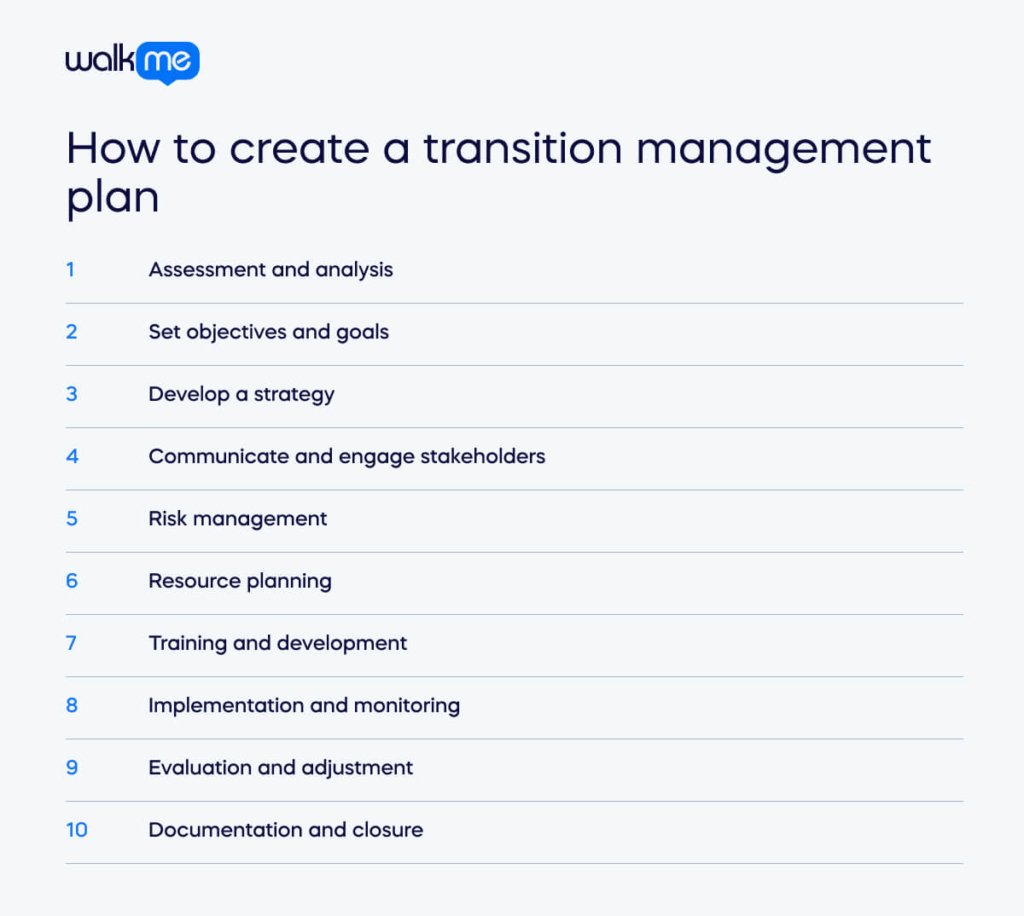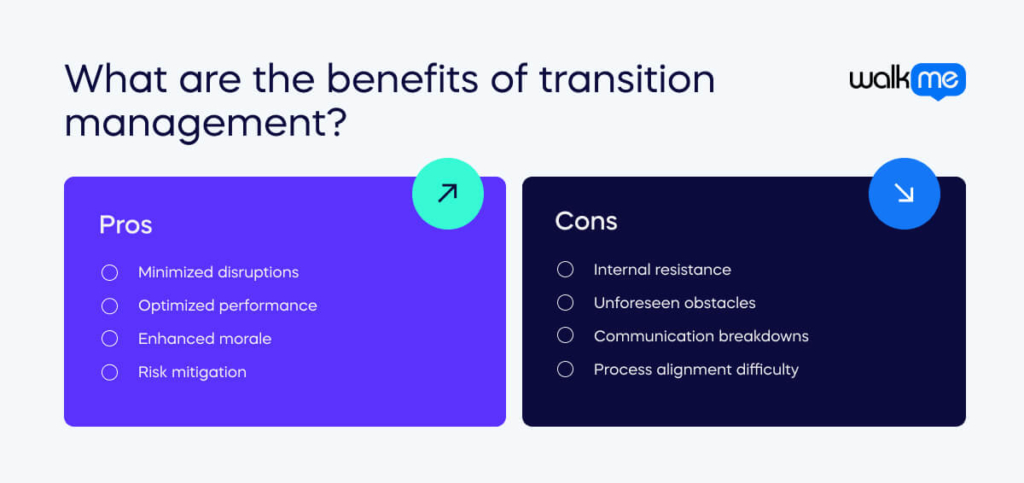With change being the only constant in the business world, ensuring successful shifts to people processes and the realigning of human resources means change management practices often take center stage.
However, change extends beyond people-centric aspects. Macro changes across broader organizational structures, including shifts to essential systems, processes, and critical business operations, more accurately describe transition management.
This type of change configures the human resources transition and facilitates the end-to-end organizational change process when navigating from a current state to a desired future state.
This involves managing change from an executive level and appointing transition managers to oversee external shifting processes among customers, suppliers, and key stakeholders.
Simply put, change management deals with “what” changes, while transition management deals with “how” everyone handles those changes. This ensures a comprehensive approach to navigating changes within and beyond the organization.
This article delves into the differences between change management and transition management, discussing their benefits, challenges, and evolutions while providing insights on crafting a transition management plan.
What is transition management?
Transition management is a set of tools and steps that help organizations handle change. It helps them move smoothly from one way of working to another.
Transition management goes beyond just dealing with people. It also involves changing a company’s systems, processes, and operations. Important goals include planning, managing, and making these changes in a way that considers all parts of the organization.
Transition management can also mean carefully moving money, investments, and other assets from one owner to another. This needs careful planning to ensure the assets are safe and perform well during the move.
Change management is about making specific changes, like creating new rules. Transition management helps people and the entire organization get used to and accept these changes.
How to create a transition management plan

A transition management plan is crucial, as it provides a structured framework to effectively navigate organizational change, ensuring smooth transitions, minimizing disruptions, and maximizing the likelihood of successful outcomes.
Let’s take a closer look:
- Assessment and analysis
Start by determining what the organization needs and where changes should occur. Then, examine closely how things are done now to identify problems and areas for improvement. Finally, consider potential opportunities and risks.
This deep analysis is the basis for a good transition management plan. It needs to be specific to the organization’s needs. By knowing exactly where to focus, the organization can make the changes smoothly and use its resources wisely. This makes sure the changes are focused and effective.
- Set objectives and goals
Set clear goals that connect to the company’s big-picture plan. Describe exactly what you want to achieve with the changes. Use SMART goals (Specific, Measurable, Achievable, Relevant, Time-bound). This gives you a way to track progress and see if you’re on track. It also helps everyone stay focused on what’s important.
These goals are like a map for the change process. They help you use your time and money wisely to reach important milestones. Setting clear goals keeps everyone motivated and on the same page. This leads to better decision-making and helps the company achieve its long-term vision.
- Develop a strategy
Create a detailed strategy for how the changes will happen. Use what you learned during your earlier analysis. This strategy should include clear steps, a timeline, and how you will use your resources.
This strategy is like a guidebook for the change process. It helps everyone involved understand what needs to happen. Clearly outline who is responsible for what and how people will communicate. This will make the changes go more smoothly and get everyone on the same page.
- Communicate and engage stakeholders
Talk to everyone involved in the changes. Be clear and honest about why the changes are needed. Ask for their feedback and ideas. Ensure your communication fits each group of people and explains how the change affects them.
By including everyone in the process, they feel like they have a say. This helps them accept the change and work together. Good communication with everyone involved helps the changes go smoothly. It also uses everyone’s ideas to find new and better ways of doing things.
- Risk management
Think about what could go wrong and get in the way of the changes. This could be anything from problems with technology to people not wanting to change. Make backup plans to deal with these risks. Be proactive and plan for things to go wrong so the changes can still happen on time.
Determine which problems are most likely to happen and could cause the most damage. Focus your time and energy on dealing with those risks first. By planning for issues ahead of time, companies become stronger and more flexible. They can handle surprises and still keep working during the change process.
- Resource planning
Make sure you have the people, money, and technology to make the changes outlined in your plan. Figure out what you’ll need and when you’ll need it during the different stages of the process.
Focus your resources on the most important parts of the change process. This helps everything run smoothly and gets the most out of your time and money. By managing resources carefully, companies can avoid waste and use what they have to make the necessary changes.
- Training and development
Create training programs to help employees learn the skills to handle the changes. Think about what each job needs and how good employees are now. What new processes or technology will they need to learn?
Help employees feel comfortable with always learning new things. Give them the support and tools they need to get used to changes and do well in the company’s new environment. Investing in your employees makes them better prepared for change. This creates a strong group of workers who can help the company grow and develop new ideas.
- Implementation and monitoring
Implement the transition plan according to your timeline. Use project management tools to track progress and ensure you reach your goals. Set up ways to measure the impact of the changes and identify any areas where adjustments are needed.
Track key performance indicators (KPIs) to understand how the changes affect the organization. Be proactive in addressing issues or areas where progress is slow. Remain flexible and ready to adjust your plan to ensure a successful transition.
- Evaluation and adjustment
Thoroughly evaluate how the changes went. Compare the results to your original goals to see how well your strategies worked. Ask everyone involved for feedback to understand what went well and what could be improved. This will help with future changes.
Analyze data about how things went to find areas where you did well and where you can improve. Use this information to make changes to your plan as needed. Your company can improve its change management skills by encouraging everyone to think about and learn from the process. This means changes will happen more smoothly and strengthen your company.
- Documentation and closure
Write down the most important results and lessons learned during the change process. Include best practices that worked well so they can be used again. Compile this information into a report that can be easily shared. This will be a valuable tool for anyone involved in future changes.
Follow a structured process to officially end the change activities. Complete all remaining tasks and formally announce that the transition is over. Recognize and celebrate the hard work of the team and everyone involved. This final step gives everyone a sense of closure and prepares the organization to move forward confidently.
What are the benefits of transition management?

Transition management isn’t just a reaction; it’s a proactive approach to success.
Navigating change brings tangible benefits, ranging from reducing disruptions and optimizing performance to boosting morale and mitigating risks.
Let’s explore the concrete advantages organizations gain by embracing transition management:
Minimized disruptions
By strategically guiding transitions, organizations minimize disruptions during pivotal phases.
Optimized performance
A good strategy ensures the organization works well, even during changes.
Enhanced morale
Paying attention to how people feel boosts morale. This leads to happier, more motivated employees.
Risk mitigation
Smart transition management acts like a safety net, helping to lower the risks associated with making big changes.
Challenges to transition management
In transition management, challenges loom, demanding a nuanced understanding and proactive approach.
Let’s explore the challenges organizations face when embracing transition management:
Internal resistance
The internal landscape often resists transition; navigating this resistance requires strategic finesse.
Unforeseen obstacles
Transition initiatives may encounter unexpected obstacles, demanding adaptability and problem-solving.
Communication breakdowns
Things are harder when people don’t understand what’s changing. They might not understand the changes or why they’re important.
Process alignment difficulty
Fitting new ways of doing things into the old ways can be tricky. It takes careful planning to make it work.
The evolution of transition management
Transition management has developed significantly, reflecting changing paradigms in organizational theory and practice.
Initially rooted in change management principles, transition management has shifted towards a more holistic and proactive approach. This is largely driven by recognizing the complex interplay between internal and external factors influencing organizational change.
In the past, transition management was mostly about the technical side of change. It focused on processes, systems, and how the organization was built. But, as the world became more complex, it became clear this wasn’t enough.
Transition management also includes people, company culture, and getting everyone involved.
This change in thinking happened alongside new ideas in how organizations work. These ideas stress how everything in an organization is connected. They also show that organizations need to be able to adapt to survive in a complex world. Transition management now sees change as a complex process. It knows that many people, feedback, and unexpected things can all affect how well a change works.
The rise of agile methodologies and lean principles in project management marked a shift towards more iterative and flexible approaches to transition management. Organizations began prioritizing responsiveness, collaboration, and process improvement. This replaced rigid, top-down change models with more adaptive and participatory frameworks.
Transition management developed into a dynamic process characterized by experimentation, learning, adaptation, and continuous focus on process improvement in response to evolving challenges and opportunities.
The increasing interconnectedness of global markets and technological advances have reshaped the context in which organizations operate, causing a reevaluation of traditional approaches to transition management. Digital transformation and the Fourth Industrial Revolution underscored the importance of agility, innovation, and digital literacy in driving successful transitions.
Transition management has changed to be more well-rounded, adaptable, and inclusive. This new approach helps organizations deal with uncertainty, complex situations, and the need to work together. It also helps them be flexible and keep growing, even when things around them keep changing.
Transition management: The next change
Looking ahead, several key trends will influence the evolution of transition management. One significant trend involves leveraging emerging technologies such as artificial intelligence, automation, and predictive analytics within transition processes. These innovations offer valuable tools for improving decision-making, optimizing resource utilization, and proactively addressing future hurdles.
There’s a notable shift towards prioritizing sustainability and ethical considerations in transition management. Organizations increasingly integrate environmentally conscious practices and social responsibility into their change strategies.
More people are working from home and in different locations. This creates both challenges and opportunities for managing change. Companies will need to find new ways to communicate, work together, and get people involved in changes.
The future of transition management depends on using new technology, focusing on sustainability, and being flexible. This will help organizations succeed in the ever-changing world of business.
FAQs
Cross-functional teams ensure diverse expertise and viewpoints are included, improving risk assessment, communication alignment, and implementation effectiveness—driving smoother cross-departmental transitions.
Readiness assessments identify employee preparedness, skill gaps, and cultural dynamics early on—helping tailor training, engagement strategies, and resource allocation to ensure smoother adoption.
Bring in suppliers, customers, or partners during the planning phase whenever process or technology changes impact delivery, service levels, or compliance—mitigating external service disruption risks.
Use real-time KPI monitoring to spot adoption lags. Then, deploy targeted coaching, adjust communications based on feedback, or allocate resources to specific teams to accelerate uptake.

